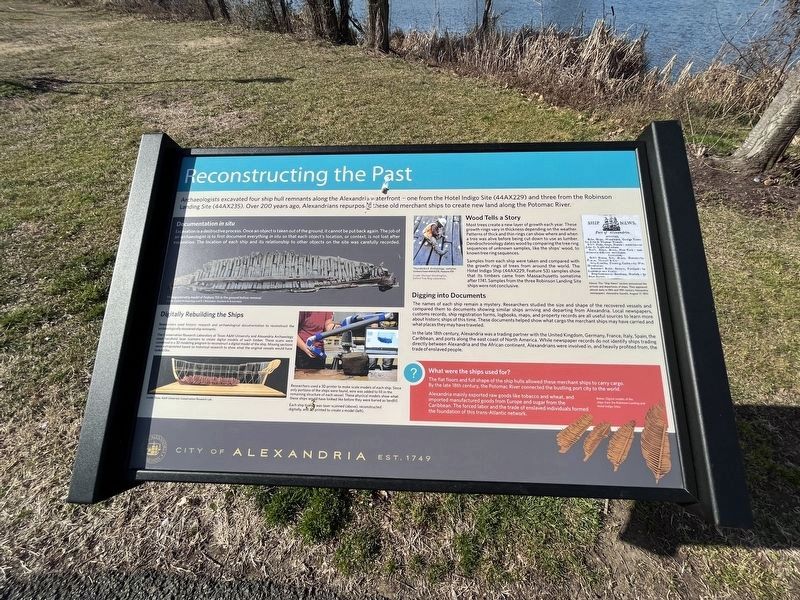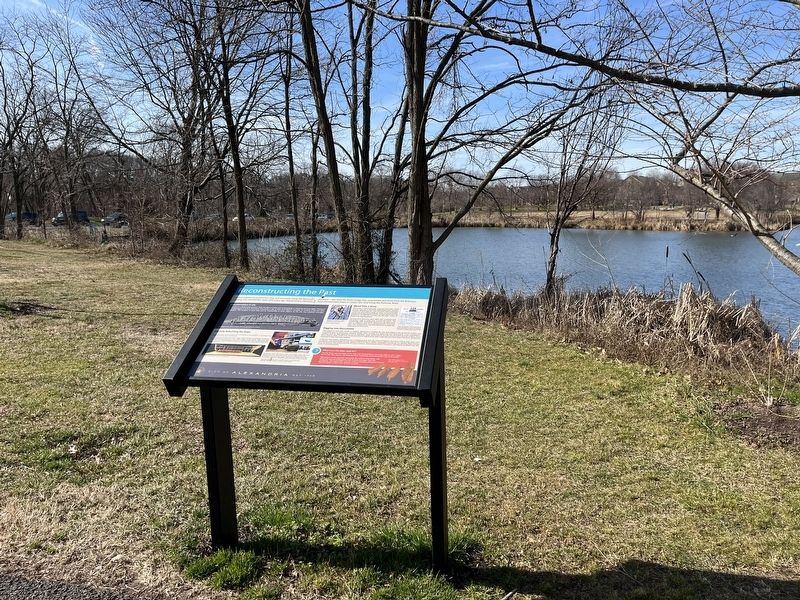Landmark in Alexandria, Virginia — The American South (Mid-Atlantic)
Reconstructing the Past
City of Alexandria
— Est. 1749 —
Archaeologists excavated four ship hull remnants along the Alexandria Waterfront — one from the Hotel Indigo Site (44AX229) and three from the Robinson Landing Site (44AX235). Over 200 years ago, Alexandrians repurposed these old merchant ships to create new land along the Potomac River.
Documentation in situ
Excavation is a destructive process. Once an object is taken out of the ground, it cannot be put back again. The job of an archaeologist is to first document everything in situ so that each object's location, or context, is not lost after excavation. the location of each ship and its relationship to other objects on the site was carefully recorded.
Digitally Rebuilding the Ships
Researchers used historic research and archaeological documentation to reconstruct the archaeologically recovered ship remnants.
The Conservation Research Laboratory at Texas A&M University and Alexandria Archaeology used handheld laser scanners to create digital models of each timber. These scans were combined in a 3D modeling program to reconstruct a digital model of the ship. Missing sections were extrapolated based on historical research to show what the original vessels would have looked like.
Researchers used a 3D printer to make scale models of each ship. Since only portions of the ships were found, wire was added to fill in the remaining structure of each vessel. These physical models show what these ships would have looked like before they were buried as landfill.
Each ship timber was laser scanned (above), reconstructed digitally, and 3D printed to create a model (left).
Wood Tells a Story
Most trees create a new layer of growth each year. These growth rings vary in thickness depending on the weather. Patterns of thick and thin rings can show where and when a tree was alive before being cut down to use as lumber. Dendrochronology dates wood by comparing the tree ring sequences of unknown samples, like the ships' wood, to known tree ring sequences.
Samples from each ship were taken and compared with the growth rings of trees from around the world. The Hotel Indigo Ship (44AX229, Feature 53) samples show that its timbers came from Massachusetts sometime after 1741. Samples from the three Robinson Landing Site were not conclusive.
Digging into Documents
The names of each ship remain a mystery. Researchers studied the size and shape of the recovered vessels and compared them to documents showing similar ships arriving and departing from Alexandria. Local newspapers, customs records, ship registration forms, logbooks, maps, and property records are all useful sources to
In the late 18th century, Alexandria was a trading partner with the United Kingdom, Germany, France, Italy, Spain, the Caribbean, and ports along the east coast of North America. While newspaper records do not identify ships trading directly between Alexandria and the African continent, Alexandrians were involved in, and heavily profited from, the trade of enslaved people.
What were the ships used for?
The flat floors and full shape of the ship hulls allowed these merchant ships to carry cargo. By the late 18th century, the Potomac River connected the bustling port city to the world.
Alexandria mainly exported raw goods like tobacco and wheat, and imported manufactured goods from Europe and sugar from the Caribbean. The forced labor and the trade of enslaved individuals formed the foundation of this trans-Atlantic network.
Erected by City of Alexandria, Virginia.
Topics and series. This historical marker is listed in these topic lists: African Americans • Anthropology & Archaeology • Colonial Era • Industry & Commerce • Waterways & Vessels. In addition, it is included in the Virginia, The City of Alexandria series list. A significant historical year for this entry is 1741.
Location. 38° 48.488′ N, 77° 6.803′ W. Marker is in Alexandria, Virginia. It is in Landmark. Marker can be reached from Brenman Park Drive south of Duke Street (Virginia Route 236), on the left when traveling west. Touch for map. Marker is at or near this postal address: 4800 Brenman Park Dr, Alexandria VA 22304, United States of America. Touch for directions.
Other nearby markers. At least 8 other markers are within walking distance of this marker. Excavating Historic Ships (within shouting distance of this marker); Ponding and Preservation (about 400 feet away, measured in a direct line); Hensley Park (approx. 0.4 miles away); James Marx All Veterans Park (approx. 0.4 miles away); Bush Hill (approx. half a mile away); This is Cameron Run! (approx. 0.7 miles away); Cloud's Mill Race (approx. 0.7 miles away); Lake Cook (approx. 0.9 miles away). Touch for a list and map of all markers in Alexandria.
Credits. This page was last revised on February 12, 2023. It was originally submitted on February 12, 2023, by Devry Becker Jones of Washington, District of Columbia. This page has been viewed 105 times since then and 19 times this year. Photos: 1, 2. submitted on February 12, 2023, by Devry Becker Jones of Washington, District of Columbia.

